Every password reset, order confirmation, and account alert your customers receive shapes their experience with your brand. Transactional emails aren’t just automated messages—they’re critical touchpoints that demand instant, reliable delivery. Yet choosing the right transactional email service from dozens of transactional email service providers can overwhelm even seasoned teams.
This guide cuts through the complexity, comparing the 10 best transactional email services for 2025. Whether you’re a startup sending hundreds of notifications or an enterprise managing millions of critical emails daily, you’ll discover which platform matches your technical needs, budget, and growth trajectory.
Let’s find your perfect email delivery partner.
What are Transactional Emails?
Transactional emails are automated, one-to-one messages sent to users after they perform a specific action — like signing up, making a purchase, or resetting a password. Unlike marketing emails and promotional messages, which target groups and promote offers, transactional emails deliver essential information tied to a user’s activity.
Examples include order confirmations, shipping updates, OTPs, and password reset emails. They play a crucial role in maintaining trust and smooth customer relationships, as recipients expect them immediately.
Because timing and deliverability matter most, these emails are usually powered by reliable SMTP server or API-based transactional email services rather than standard bulk senders.
How does SMTP Work?
SMTP (Simple Mail Transfer Protocol) is the standard technology that moves your email from the sender’s server to the recipient’s inbox placement.
Think of it as the postal system of the internet: when your app triggers a message—like a password reset—SMTP connects to your email provider’s server, verifies credentials, and hands the email off to the recipient’s mail server. That server then accepts, filters, and delivers the message to the inbox through various mail agents.
Reliable SMTP services handle email authentication, retries, and bounce management automatically, ensuring messages aren’t lost, delayed, or flagged as spam during the timely delivery process.
How to Select the Best SMTP Provider for Your Business
I’ve tested and implemented dozens of SMTP providers over the years, and I can tell you that choosing the right one goes well beyond comparing prices. You need a service that ensures every critical email reliably reaches the inbox through efficient transactional email delivery. Through trial and error, I’ve learned that the ideal provider balances speed, email deliverability, security, and integration flexibility.
Small businesses usually prioritize ease of setup process and clear analytics. Larger teams need scalable infrastructure, dedicated IPs, and compliance support.
Your right choice depends on your sending volume, technical resources, and how much control you want over deliverability management.
Here are the key factors to evaluate:
- Deliverability rate: Look for providers with a proven inbox placement rate above 98%.
- API & integration options: Check for REST APIs, SDKs, flexible SMTP endpoints, and robust application programming interface capabilities.
- Scalability: Ensure smooth performance as your email volume grows.
- Reputation management: Dedicated IPs, anti-spam filters, and suppression lists help maintain sender reputation.
- Analytics & logs: Detailed analytics dashboards for bounces, clicks, and delivery status.
- Security: Support for SPF, DKIM, and DMARC authentication standards.
- Support quality: 24/7 technical assistance is crucial for high-priority transactional flows.
Best Transactional Email Providers at Glance
- Sender — Best Transactional Email Service for Small Businesses
- Postmark — Fast Email Delivery Platform for Critical Emails
- SendGrid — Leading SMTP Service Provider for High Volume
- Mailgun — Developer-Friendly Transactional Email API
- Amazon SES — Most Affordable SMTP Relay Service
- Brevo — Email Service Provider with Marketing Automation
- MailerSend — Generous Free Transactional Email Service
- Mailjet — SMTP Provider with Newsletter Editor
- Mailtrap — Advanced Email Delivery Platform with Analytics
- SMTP.com — Enterprise-Grade SMTP Service Provider
Before moving to detailed reviews, let’s compare the costs of using different transactional email services.
| Platform | Best For | Deliverability | Free Tier | Starting Price |
| Sender | Small & midsize businesses needing marketing + transactional emails | Up to 99% deliverability with managed IPs and anti-abuse filters | Free Forever plan up to 2,500 subscribers and 15,000 emails/month | From $7/month |
| Postmark | Developers and businesses sending mission-critical notifications | Excellent – sub-second delivery via dedicated transactional infrastructure | Free 14-day trial | From $15/month |
| SendGrid | High-volume enterprises and multi-brand organizations | Very strong, though shared IP pools can fluctuate | Free 60-day trial (100 emails/day) | From $19.95/month |
| Mailgun | Developers and SaaS teams needing full API control | High – depends on configuration and region | Free plan (100 emails/day) | From $15/month |
| Amazon SES | Developers and AWS users sending bulk transactional emails | Excellent, scalable, self-managed deliverability | Free 12-month tier (up to 3,000 emails/month) | Pay-as-you-go (~$0.10/1,000 emails) |
| Brevo | Businesses wanting unified marketing + transactional platform | Good for general use; slower during peaks | Free plan (300 emails/day) | From $8/month |
| MailerSend | Startups and small apps testing transactional workflows | Strong and consistent at moderate volumes | Free plan (500 emails/month) | From $25/month |
| Mailjet | Teams combining marketing and transactional emails | Reliable for moderate senders; less for enterprise scale | Free plan (6,000 emails/month) | From $17/month |
| Mailtrap | Developers and QA teams testing and monitoring delivery | Excellent visibility with pre-delivery sandbox checks | Free plan (3,500 emails/month) | From $15/month |
| SMTP.com | Enterprises needing dedicated IPs and deliverability management | Excellent with proactive reputation protection | None | From $25/month |
10 Best Transactional Email Services Reviewed
After testing dozens of transactional email services over the past few years, I’ve pulled together this comparison of the ones that consistently deliver for online businesses.
These are the platforms that help you build trust with customers and, more importantly, keep them updated:
Sender — Best Transactional Email Service for Small Businesses
I’ve been impressed with Sender‘s transactional email infrastructure—it’s built for speed, reliability, and control.
With Sender you can send transactional emails like password resets, OTPs, order confirmations, and shipping alerts through SMTP or API with what I’ve found to be near-instant delivery.
The managed IP system (shared IP or dedicated) has been a game-changer for me because it removes the need for manual warm-ups while maintaining up to 99% deliverability through bounce monitoring, anti-abuse filters, and authentication (SPF, DKIM, DMARC).
I also appreciate the flexible REST endpoints, webhooks, and dynamic transactional email templates powered by Liquid syntax for personalization. The real-time logs, email analytics, and email tracking have made managing transactional emails and troubleshooting effortless in my experience, while the 10MB attachment support ensures invoices and receipts land securely.
Whether you’re running a small shop or SaaS platform, I’ve found Sender provides enterprise-grade transactional reliability — even on its free plan.

Key Features
- Up to 99% deliverability. Managed shared and dedicated IPs ensure fast inbox delivery without manual warm-up headaches.
- Real-time tracking. Monitor deliveries, bounces, and opens instantly through detailed analytics and event logs.
- Dynamic templates. Edit, localize, or personalize messages using Liquid syntax—no code changes required.
- Advanced security. Built-in SPF, DKIM, and DMARC authentication with bounce management and suppression lists.
Ideal For
Sender is ideal for small to midsize businesses that want reliable transactional delivery combined with automation and marketing capabilities in one platform. It’s particularly suited for growing ecommerce stores and SaaS apps that prioritize deliverability and simplicity.
- Small and midsize businesses. Enjoy enterprise-level reliability and analytics without complex setup or developer overhead.
- Ecommerce and SaaS platforms. Automate order confirmations, password resets, and account alerts within the same ecosystem.
Pros & Cons
Pros
- High deliverability rates with managed shared and dedicated IPs.
- Unified platform for both marketing and transactional messages, offering excellent value for money.
- Strong analytics, tracking, and template management tools.
Cons
- Sender branding in free plan.
- No multi-region data hosting yet.
- No inbound email routing yet.
Pricing
- Free Forever plan: $0 (2,500 contacts & 15,000 emails/month);
- Standard: from $7/month (1,000 contacts & 12,000 emails/month);
- Professional: from $14/month (1,000 contacts & 24,000 emails/month);
- Enterprise: Custom price.
See why businesses choose Sender:
Postmark — Fast Email Delivery Platform for Critical Emails
What sets Postmark apart is how it isolates transactional vs. marketing emails traffic through dedicated “Message Streams,” ensuring time-sensitive emails like password resets or account alerts reach inboxes instantly. The infrastructure is optimized for speed and reliability, with open rate and click rate tracking that’s configurable per message type in just a few minutes.
I appreciate Postmark’s detailed message activity feed and API that exposes delivery events, metadata, and bounce data. It also offers a well-maintained template library that I’ve found renders consistently across clients. The only limitation I’ve encountered is its narrow focus — you get minimal marketing automation or multi-channel features.
For developers and businesses prioritizing critical email reliability over everything else, Postmark remains one of the fastest options I’ve worked with.
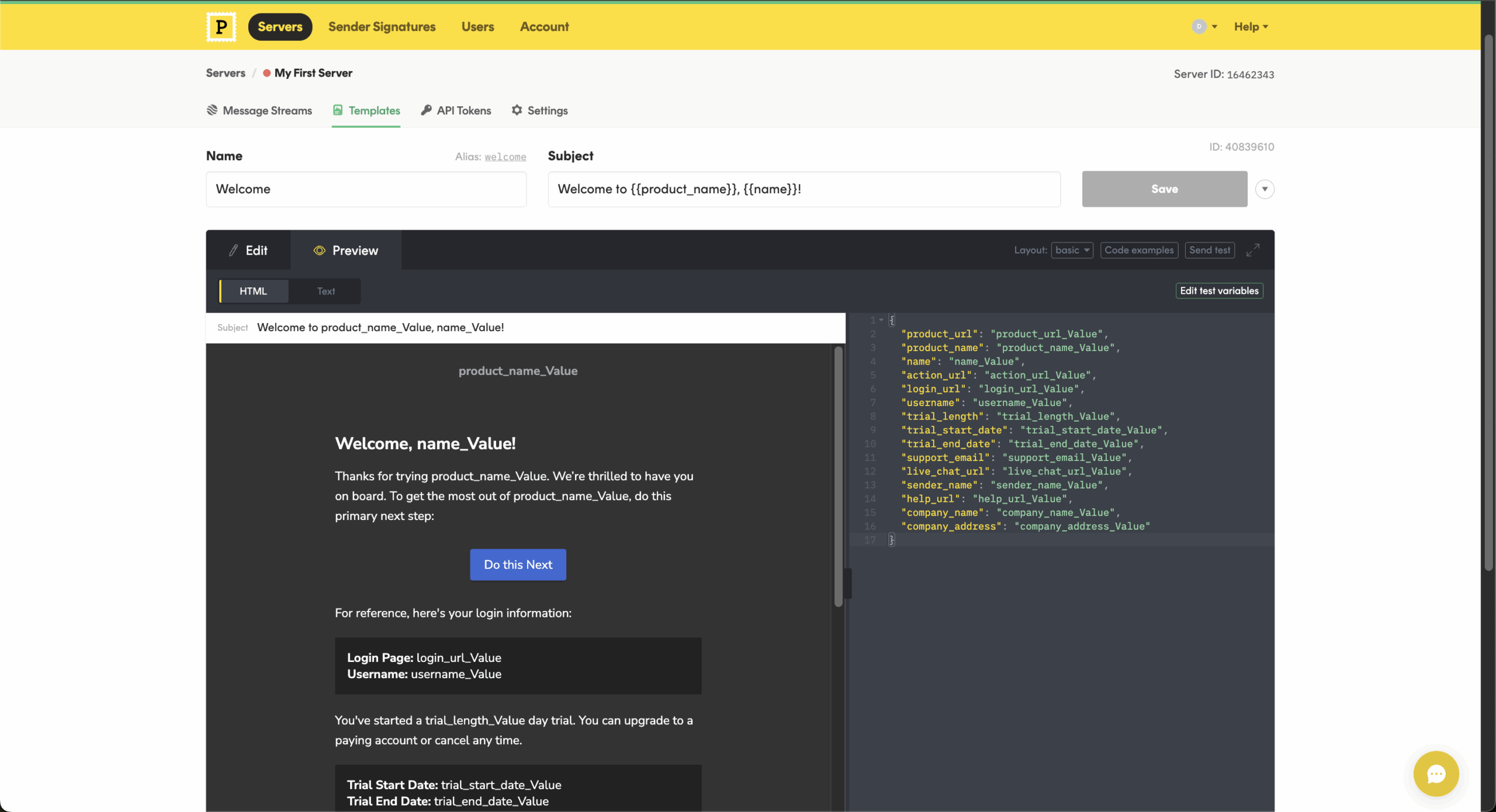
Key Features
- Message streams. Separate transactional and promotional traffic for consistent speed and inbox placement.
- Instant delivery. Optimized infrastructure ensures time-sensitive emails reach inboxes within seconds.
- Detailed activity feed. Track every email’s journey with searchable logs and event-level insights.
- Webhooks and APIs. Get real-time event data for custom dashboards or automated workflows.
Ideal For
Postmark is best for companies that depend on instant and guaranteed delivery of mission-critical emails. It’s designed for technical teams where transactional reliability, clear visibility, and API-driven control outweigh marketing or automation needs.
- Technical teams. Build and monitor transactional workflows using simple, developer-friendly APIs.
- Security-first organizations. Deliver account notifications and verification emails with sub-second speed and consistency.
Pros & Cons
Pros
- Exceptionally fast delivery for critical transactional emails.
- Transparent event tracking and detailed message logs.
- Clean, developer-friendly API and documentation.
Cons
- No marketing or automation features.
- Limited geographic data center options.
- Pricing higher than some high-volume alternatives.
Pricing
- Free 14-day trial
- Basic: from $15/month (10,000 emails/month a);
- Pro: from $16.50/month (10,000 emails/month n);
- Enterprise: $18/month (10,000 emails/month and unlimited users).
SendGrid — Leading SMTP Service Provider for High Volume
SendGrid, now part of Twilio, is a go-to powerhouse when working with businesses sending millions of emails monthly.
SendGrid provides SMTP relay and a flexible Email API with dynamic transactional templates that let developers call pre-built layouts while marketers edit content without redeploying code.
I’ve found the deliverability insights, bounce rate tracking, and engagement analytics integrated into a single dashboard particularly useful. High-volume users can request dedicated IPs to isolate reputation—something I’ve implemented for several enterprise clients.
While the system is robust, I’ve noticed smaller teams may find it overengineered, and the initial setup can be intimidating. Shared IP pools also mean I’ve experienced occasional delays during traffic surges.
Still, for enterprise-level reliability, SendGrid offers one of the most scalable transactional infrastructures I’ve worked with.

Key Features
- Dynamic templates. Build, store, and update transactional templates without code redeployment.
- Scalable infrastructure. Handle millions of daily sends with dedicated IPs and high throughput.
- Comprehensive analytics. Measure delivery, open, and click rates through visual dashboards.
- Subuser management. Assign separate IPs and credentials for multiple brands or applications.
Ideal For
SendGrid is built for high-volume senders who need scalable infrastructure, advanced analytics, and collaborative template management. Its versatility makes it a strong choice for enterprises and multi-brand organizations balancing marketing campaigns and transactional communications.
- Large enterprises. Manage millions of daily sends across brands and departments with dedicated IPs.
- Cross-functional teams. Enable marketers and developers to co-manage templates and analytics in real time.
Pros & Cons
Pros
- Extremely scalable infrastructure for enterprise-level volume.
- Dynamic template builder supports collaboration between teams.
- Comprehensive analytics and event webhooks.
Cons
- Can feel complex for small businesses.
- Shared IP pools sometimes experience deliverability fluctuations.
- Customer support response can vary by plan tier.
Pricing
- Free 60-day trial (100 emails/day);
- Essentials: from $19.95/month (50,000-100,000 emails/month);
- Pro: from $89.95/month (100,000-2,500,000 emails/month);
- Pro: Custom pricing.
Mailgun — Developer-Friendly Transactional Email API
Mailgun has been my preferred choice when I need fine-grained control over transactional emails.
Mailgun offers a RESTful API, SMTP relay fallback, and regional data centers in the US and EU to meet compliance requirements—features I’ve leveraged for GDPR-compliant implementations. The SDK support for multiple programming languages makes integration straightforward.
The deliverability tooling includes detailed event logs, suppression lists, and bounce categorization that have helped me diagnose issues quickly. I can manage routing logic, inbound email handling, and domain-level authentication with precision.
Mailgun’s analytics dashboard provides insight into open and click behavior while allowing webhook-based integrations for custom monitoring I’ve built. The downside I’ve encountered: setup and maintenance are technical, with fewer no-code or visual design tools than hybrid marketing platforms.
Mailgun ideal for SaaS products or apps that prioritize control, scalability, and compliance above ease of use when selecting their transactional email software.
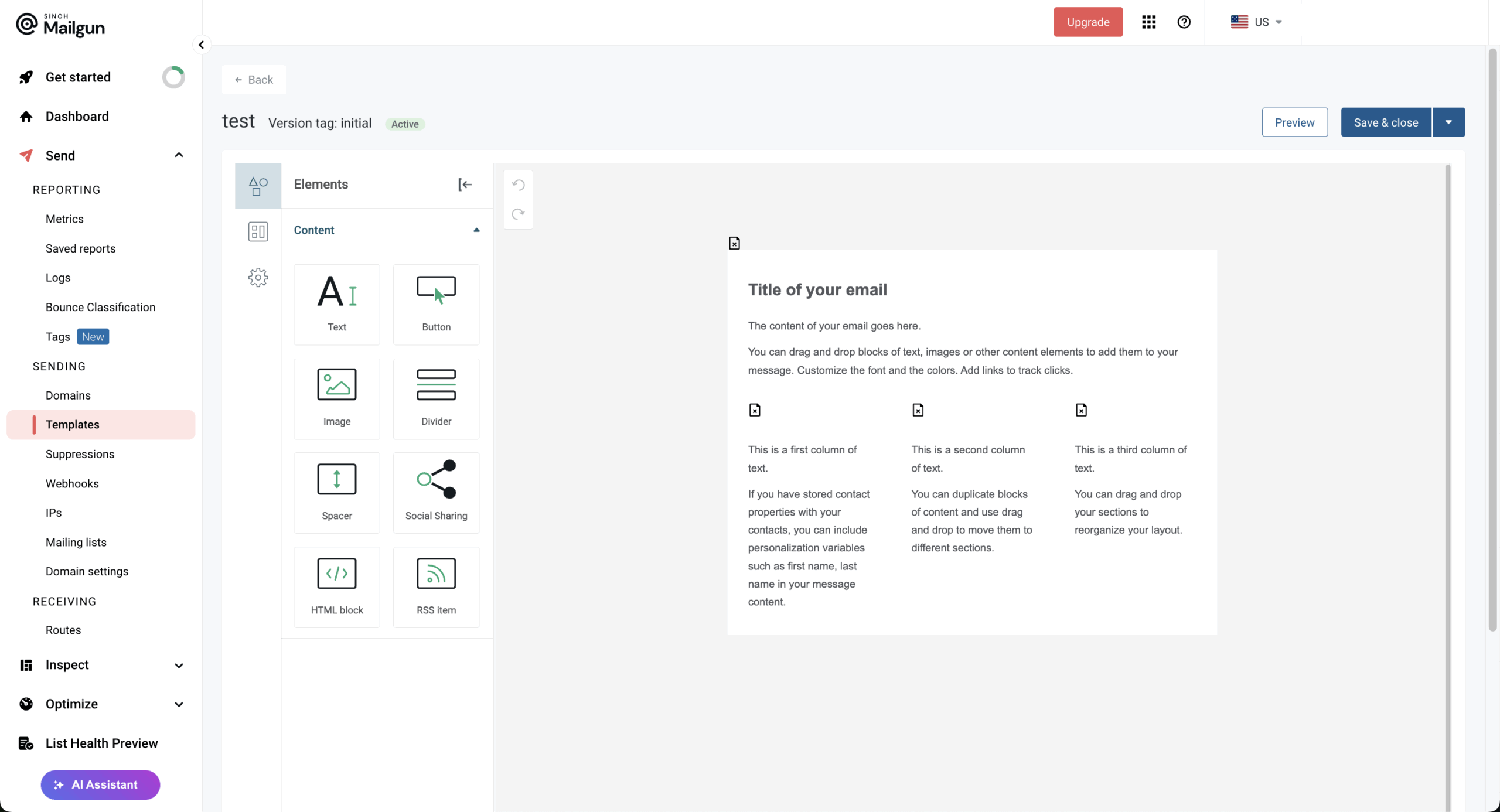
Key Features
- Powerful API. Flexible REST endpoints for sending, validating, and tracking transactional messages.
- Regional data centers. Choose US or EU servers for compliance and data sovereignty.
- Inbound routing. Process and respond to incoming messages programmatically.
- Deliverability suite. Monitor reputation, suppress bounces, and analyze inbox performance metrics.
Ideal For
Mailgun is perfect for developers and SaaS teams needing full API-level control over email sending, routing, and compliance. It’s best suited for technical environments that prioritize precision, reliability, and region-based data management.
- Engineering-led businesses. Customize email logic and handle inbound routing directly from code.
- Compliance-focused industries. Choose EU or US regions to meet data protection regulations.
Pros & Cons
Pros
- Developer-focused API with extensive customization options.
- Regional data storage for compliance flexibility.
- Reliable deliverability and suppression management tools.
Cons
- Requires strong technical knowledge to set up.
- No drag-and-drop editor for non-technical users.
- Pricing increases with advanced deliverability add-ons.
Pricing
- Free plan (100 emails/day)
- Basic: from $15/month (10,000+ emails/month);
- Foundation: from $35/month (50,000+ emails/month);
- Scale: from $90/month (100,000+ emails/month).
Amazon SES — Most Affordable SMTP Relay Service
Amazon Simple Email Service (SES) has consistently been the most cost-efficient transactional email option I’ve implemented.
Amazon SES integrates seamlessly with other AWS tools like CloudWatch for monitoring and SNS for bounce or complaint notifications—integrations I use regularly. SES supports both SMTP and API sending, along with dedicated IP options for large senders.
In my experience, deliverability management is largely self-service — I handle domain authentication, suppression lists, and IP warm-up myself. The trade-off for its low price is the technical overhead: there’s no built-in dashboard for content or analytics like modern ESPs offer.
I recommend SES for developers or teams already using AWS infrastructure who want full control and unbeatable cost efficiency.

Key Features
- Low-cost sending. Pay-as-you-go pricing model ideal for large volumes.
- AWS integration. Works seamlessly with CloudWatch, SNS, and IAM for monitoring and control.
- Dedicated IPs. Option to manage or automate IP warm-up and reputation.
- Event feedback. Receive bounce and complaint notifications via Amazon SNS.
Ideal For
Amazon SES fits businesses already operating within AWS or developers seeking ultra-low-cost, high-volume transactional email. It’s designed for teams that prefer infrastructure-level control over convenience or pre-built dashboards.
- AWS users. Integrate SES seamlessly with CloudWatch, SNS, and Lambda for full automation.
- Bulk senders. Send millions of transactional and bulk emails with minimal operational cost.
Pros & Cons
Pros
- Industry-leading affordability for large-scale senders.
- Seamless AWS integration for monitoring and automation.
- High scalability and performance.
Cons
- Minimal built-in UI and analytics.
- Requires technical expertise to manage properly.
- No dedicated customer support without AWS business plan.
Pricing
- Free 12-month tier (up to 3,000 emails/month);
- Pay-as-you go starting at $0.10/1000 emails.
Brevo — Email Service Provider with Marketing Automation
Brevo (formerly Sendinblue) has impressed me by combining transactional email with full email marketing service and email marketing software automation in one unified dashboard.
As a comprehensive email marketing tool, Brevo’s SMTP relay and Messaging API allow for password resets, notifications, and order confirmations with detailed logs and webhooks. I’ve found it convenient that transactional and campaign emails share the same authentication and infrastructure, making it simple to manage both.
Users also benefit from extended log retention and reply handling through inbound parsing—features I’ve used extensively.
However, because Brevo covers many channels — email, SMS, WhatsApp, and CRM — I’ve noticed its transactional feature set isn’t as specialized or latency-focused as dedicated platforms. It’s ideal for growing businesses that prefer one ecosystem for marketing and transactional communication instead of managing multiple tools like I used to.
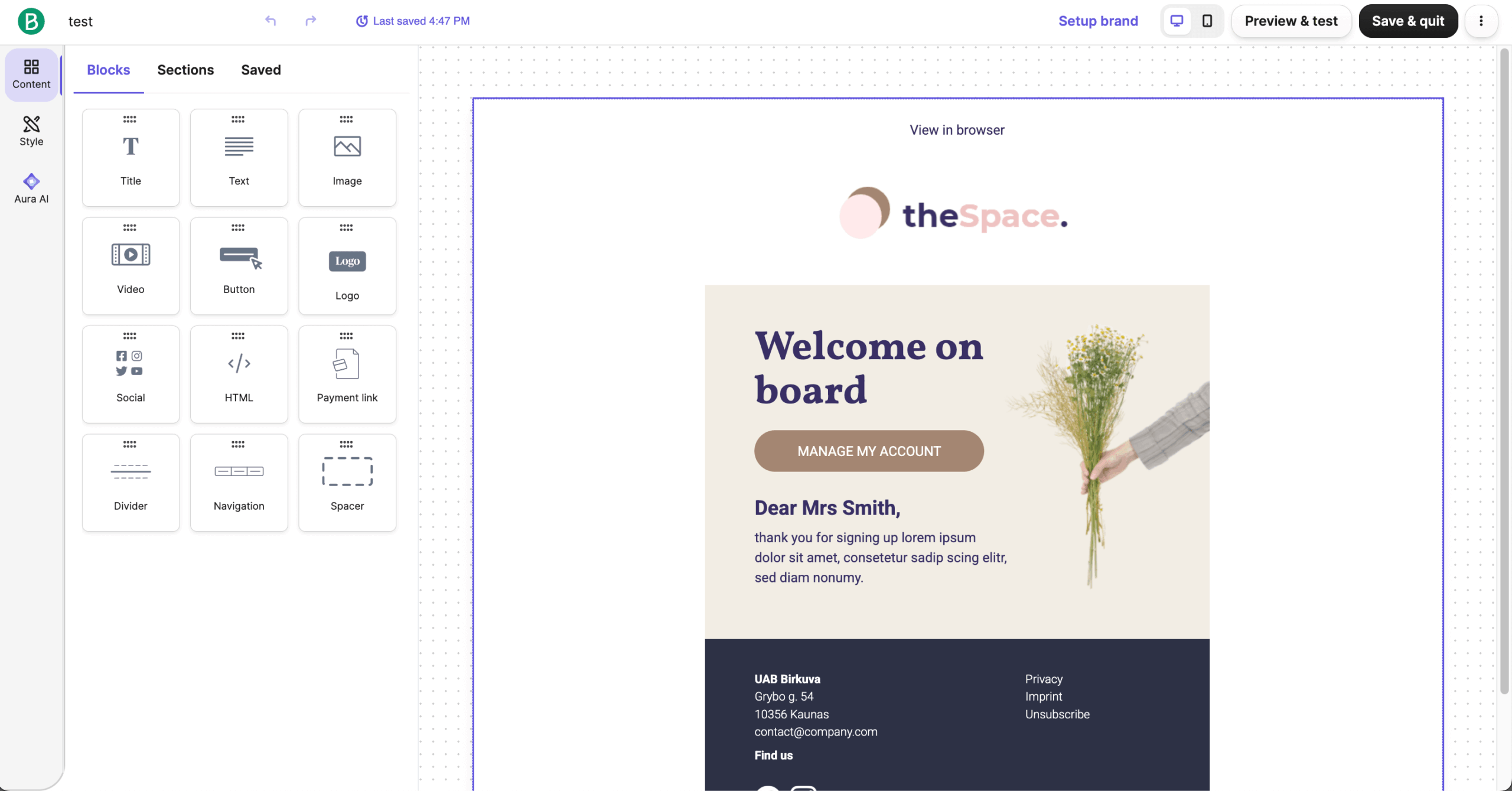
Key Features
- SMTP and API access. Send critical transactional emails instantly via flexible integration options.
- Unified platform. Combine transactional, marketing, and SMS campaigns under one system.
- Inbound parsing. Convert replies into events or support tickets automatically.
- Extended log retention. Keep detailed delivery records for auditing and analysis.
Ideal For
Brevo is ideal for small to mid-size businesses that need an all-in-one platform for marketing, transactional, and SMS messaging. Its approachable design suits teams with limited technical expertise seeking reliable multi-channel delivery.
- Growing businesses. Centralize all communications—transactional, marketing, and automation—in one intuitive platform.
- Omnichannel marketers. Sync email, SMS, and workflows for consistent customer experiences.
Pros & Cons
Pros
- Combines marketing, transactional, and automation features in one platform.
- Intuitive interface suitable for non-technical users.
- Flexible pay-as-you-go pricing.
Cons
- Transactional capabilities less advanced than specialist tools.
- Delivery speed can fluctuate under heavy load.
- Logs and reporting capped in lower tiers.
Pricing
- Free plan (300 emails/day);
- Free 60-day trial: $0 (250 contacts—500 email sends);
- Starter: from $8/month (5,000+ emails/month);
- Standard: from $16/month (5,000+ emails/month);
- Professional: $449/month;
- Enterprise: Custom price (1M+ emails/month).
MailerSend — Generous Free Transactional Email Service
MailerSend, built by the team behind MailerLite, provides what I consider a refreshingly clean, modern interface with SMTP relay, REST API, inbound routing, and domain management features.
With MailerSend you can send from multiple domains, manage suppression lists, and monitor detailed delivery analytics. The standout advantage I’ve noticed is its approachable design as a user-friendly solution — even non-technical users on my team can handle template updates or view logs without code.
The free tier allows 500 emails per month, which I’ve found ideal for small applications or startups testing transactional delivery. For larger senders, paid plans unlock dedicated IPs, higher limits, and priority support.
In short, MailerSend strikes a rare balance between developer-level flexibility and everyday usability that I appreciate.
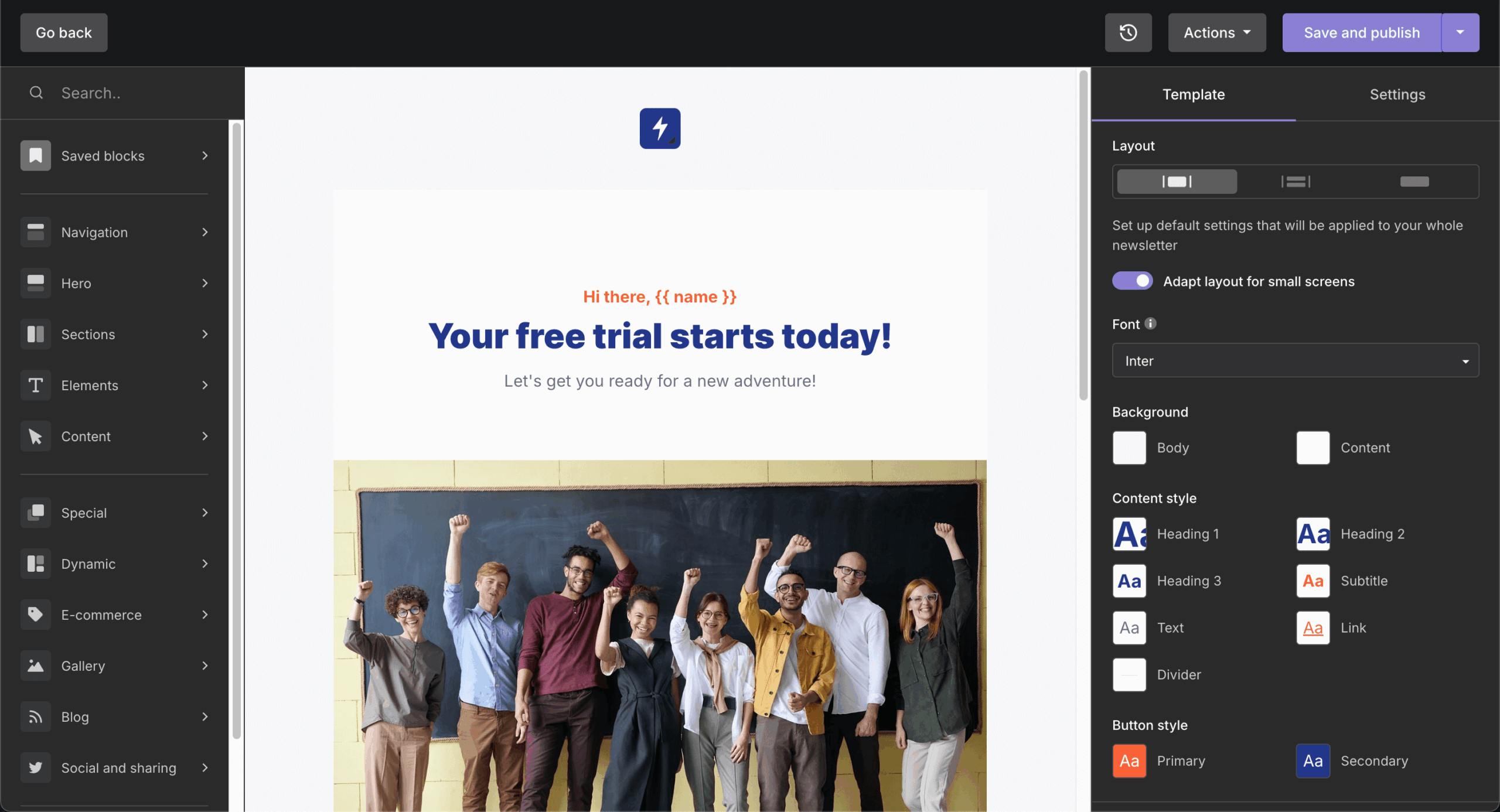
Key Features
- Free tier access. Send up to 500 transactional emails monthly for testing or small apps.
- Visual template builder. Create responsive transactional layouts without coding.
- Inbound routing. Automatically handle user replies or contact form submissions.
- Comprehensive analytics. Track delivery, bounce, and engagement metrics in real time.
Ideal For
MailerSend fits startups, small businesses, and development teams that want modern transactional features without enterprise complexity. It’s user-friendly yet API-driven, making it ideal for rapid deployment and small-scale production.
- Startups and indie developers. Test transactional flows affordably using the free monthly allowance.
- Technical teams. Customize workflows with inbound routing and REST APIs.
Pros & Cons
Pros
- Clean, modern UI with easy onboarding.
- Developer-friendly REST API and webhook support.
- Free tier available for testing or small projects.
Cons
- Advanced features like dedicated IPs require higher plans.
- Limited deliverability customization compared to enterprise tools.
- Smaller ecosystem than legacy providers.
Pricing
- Free plan (500 emails/month);
- Hobby: from $6/month (5,000+ emails/month);
- Starter: from $28/month (50,000+ emails/month);
- Professional: $88/month (50,000+ emails/month).
Mailjet — SMTP Provider with Newsletter Editor
Mailjet has been useful in my projects by merging transactional delivery with marketing features, allowing both developers and content teams to work in one environment.
Mailjet offers SMTP relay and an API with real-time tracking, variable substitution, and templating logic for automated notifications like receipts and password resets. What I particularly like is that non-technical users can design transactional messages using the same drag-and-drop builder used for newsletters, streamlining brand consistency.
The collaboration features that let teams comment or version-control templates directly inside the platform have saved me from countless email chains. While its transactional performance is solid in my experience, advanced deliverability tools and IP management are more limited than in developer-centric providers.
Mailjet works perfectly for teams that want to handle all email communication from a single, collaborative workspace.
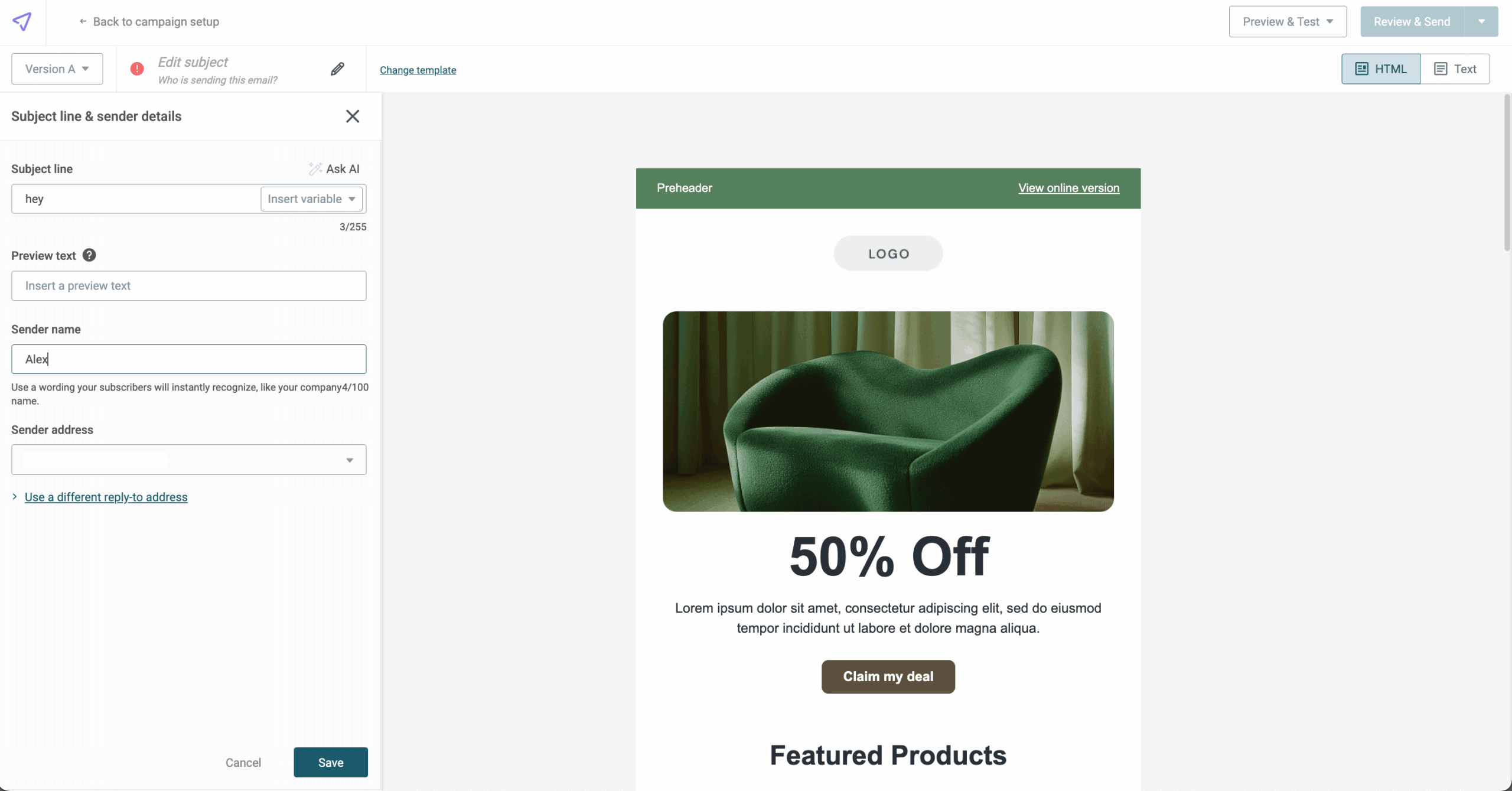
Key Features
- Drag-and-drop editor. Design transactional templates that match your brand easily.
- Collaborative tools. Allow teams to comment, edit, and approve templates together.
- Real-time tracking. Monitor delivery status, opens, and engagement as they happen.
- Templating language. Use variables and loops for personalized transactional content.
Ideal For
Mailjet is a solid choice for teams that need both marketing and transactional email capabilities in one workspace. It’s designed for collaboration between marketers, designers, and developers maintaining brand consistency and consistent communication.
- Hybrid teams. Coordinate design and delivery of transactional messages effortlessly.
- Agencies. Manage multiple client accounts under one organized platform.
Pros & Cons
Pros
- Combines marketing and transactional sending in one dashboard.
- Collaborative editor supports teamwork on templates.
- Real-time tracking and analytics.
Cons
- Transactional feature set is less specialized than dedicated services.
- Occasional deliverability issues on shared IPs.
- Support can be slower on entry-level plans.
Pricing
- Free plan (6,000 emails/month)
- Essential: from $17/month (15,000+ emails/month);
- Premium: from $27/month (15,000+ emails/month);
- Custom: pricing upon request.
Mailtrap — Advanced Email Delivery Platform with Analytics
Mailtrap combines two powerful modes that I’ve found invaluable: a sandbox environment for testing emails in staging and a production-ready SMTP/API service for real sending.
With Mailtrap, I can safely preview test emails without spamming users, then switch to live mode once approved. The detailed analytics track deliveries, bounces, spam complaints, and client rendering, helping me pinpoint issues early. Built-in authentication support (SPF, DKIM, DMARC), email validation service capabilities, and webhook integrations provide full visibility into email performance.
Mailtrap’s strong debugging tools have made it especially popular among the software teams and QA engineers. The interface is more technical than design-focused, but for testing and reliable delivery, few services offer this depth of control and diagnostic data in my experience.

Key Features
- Sandbox testing. Safely preview transactional emails without sending to real users.
- Detailed analytics. Track opens, clicks, and spam scores with visual reports.
- SMTP and API support. Send transactional emails from staging or production environments.
- Deliverability insights. Identify spam folder risks and authentication errors before going live.
Ideal For
Mailtrap is ideal for development, QA, and DevOps teams that want to preview, test, and debug transactional emails before production. It bridges pre-deployment testing with reliable live sending.
- Developers. Test transactional flows in sandbox mode without spamming users.
- QA specialists. Verify deliverability, formatting, and authentication before release.
Pros & Cons
Pros
- Unique sandbox mode for safe email testing.
- Strong analytics and deliverability insights.
- Smooth transition from test to production environment.
Cons
- Interface aimed at developers, not marketers.
- Limited template customization tools.
- Paid plans required for full production sending volume.
Pricing
- Free plan (3,500 emails/month)
- Basic: from $15/month (10,000+ emails/month);
- Business: from $85/month (100,000+ emails/month);
- Enterprise: from $750/month (1,5M+ emails/month).
SMTP.com — Enterprise-Grade SMTP Service Provider
SMTP.com, one of the oldest dedicated email relay services I’ve worked with, is designed for businesses sending large volumes of transactional messages.
SMTP.com provides dedicated IPs, domain authentication, bounce tracking, and real-time delivery analytics. A unique feature I appreciate is Reputation Defender, which automatically filters risky addresses and manages suppression lists before each send, protecting sender reputation.
The infrastructure is tuned for high throughput and consistent inbox placement, making it a trusted choice for enterprise communications in my experience. However, I’ve found its interface and setup feel more traditional compared to newer SaaS platforms, and pricing may exceed smaller teams’ needs.
SMTP.com works best for enterprises needing guaranteed capacity, stability, and proactive reputation management.

Key Features
- Reputation Defender. Cleans contact lists and suppresses risky addresses automatically.
- Dedicated IPs. Maintain full control of sender reputation and deliverability.
- High-volume scalability. Built to handle enterprise-level throughput with minimal latency.
- Comprehensive reporting. Real-time dashboards for delivery rates, bounces, and engagement.
Ideal For
SMTP.com caters to enterprises and established businesses that demand reliable, large-scale transactional delivery. It’s optimized for organizations where email performance directly impacts operations and customer experience.
- Enterprise senders. Manage massive email volumes with minimal latency and dedicated support.
- Transactional-heavy industries. Deliver OTPs, receipts, and critical notifications consistently.
Pros & Cons
Pros
- Proven reliability for enterprise-scale transactional sending.
- Reputation Defender feature protects deliverability proactively.
- Dedicated IPs and feedback loops included.
Cons
- Older interface compared to modern SaaS tools.
- Setup may require technical assistance.
- Higher pricing tiers than small-business alternatives.
Pricing
- Essential: from $25/month (50,000+ emails/month);
- Starter: from $80/month (100,000+ emails/month);
- Growth: from $300/month (500,000+ emails/month);
- Business: from $500/month (1,000,000+ emails/month);
Which Transactional Email Service Should You Choose?
If you’re a small to medium business seeking reliability, simplicity, and built-in marketing tools, start with Sender — it offers professional transactional delivery and automation in one streamlined platform.
For critical, time-sensitive notifications, Postmark is unmatched in speed and inbox precision. SendGrid and Mailgunsuit high-volume senders needing scalability and advanced APIs, while Amazon SES is ideal for developers prioritizing low-cost, infrastructure-level control.
Brevo is great for teams wanting unified marketing and transactional messaging. Mailjet fits collaborative marketing environments, Mailtrap helps developers test and debug, and SMTP.com serves enterprises requiring maximum deliverability and reputation management.
FAQs
What is the difference between transactional and marketing emails?
Transactional emails are triggered by a user’s action—like order confirmations, password resets, or OTPs—where timing and deliverability are critical. Marketing emails, on the other hand, are promotional and sent to groups, such as newsletters or offers. Platforms like Sender handle both, so you can manage essential notifications and campaigns from one place without juggling multiple tools.
Do I need a transactional email service?
Yes—if your business sends automated notifications, a dedicated transactional email service is essential. It ensures password resets, order confirmations, and account alerts reach inboxes instantly and securely. Unlike standard mail servers, tools like Sender offer high deliverability, authentication, and real-time tracking to protect your domain reputation and customer experience.
How much do transactional email services cost?
Pricing varies by provider and email volume. Entry plans start around $7–$15 per month for a few thousand emails, while enterprise solutions scale by usage or IP type. Sender includes transactional capabilities in its Professional and Enterprise plans, offering top-tier deliverability and analytics at a fraction of competitors’ cost. Many services offer free trials to test their platforms before committing.
Do I need a dedicated IP address for transactional emails?
A dedicated IP isn’t mandatory, but it helps maintain consistent reputation and deliverability—especially if you send large volumes or time-sensitive messages. Sender provides both managed shared IPs and optional dedicated ones, so smaller businesses can skip complex warm-ups while larger senders get complete control over their email reputation. Mailbox providers typically view dedicated IPs more favorably for bulk emails.
Why are my transactional emails going to spam?
Transactional emails may land in spam due to authentication issues, poor sender reputation, or shared IP abuse. Ensure SPF, DKIM, and DMARC are properly configured, and avoid spammy content. Using a platform like Sender helps prevent this—its built-in authentication, bounce tracking, and anti-abuse filters protect deliverability automatically.
A bulk email service with proper infrastructure significantly reduces spam folder placement. Consider phone support and chat support options when choosing a provider to help troubleshoot deliverability issues.














